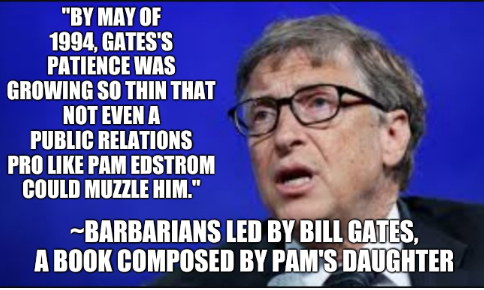
!['He [Bill Gates] is divisive. He is manipulative. He is a user. He has taken much from me and the industry.' -Gary Kildall](http://techrights.org/wp-content/uploads/2020/01/Bill-Gates-is-divisive-kildall.jpg)
THERE's a story or two surrounding the relatively mysterious death of Gary Kildall at the age of 52. The story I heard as a young person may have changed over time (revisionism by the 'victor' plays a role), but Wikipedia puts it like this (at this time): "On July 8, 1994, Kildall fell at a Monterey, California, biker bar and hit his head.[26] The exact circumstances of the injury remain unclear. He had been an alcoholic in his later years.[15][27] Various sources have claimed he fell from a chair, fell down steps, or was assaulted, because he had walked into the Franklin Street Bar & Grill wearing Harley-Davidson leathers.[12] He checked in and out of the hospital twice, and died three days later at the Community Hospital of the Monterey Peninsula. An autopsy the next day did not conclusively determine a cause of death.[25][1] A CP/M Usenet FAQ says he was concussed from the fall and died of a heart attack; the connection between the two are unclear.[28] He is buried in Evergreen Washelli Memorial Park in north Seattle."
"No matter if people retire early (unhappy with the way things are going), or leave due to health circumstances, or are forced to resign, or die earlier than expected and so on… the net effect is that they have less of a role to play."To quote an associate of ours, "I read on TR (Techrights) that Bruce Perens has been driven out of OSI. Do you have a list? Guido, RMS, Linus, probably many others."
"Perens himself left," I responded, "after seeing the OSI doing bad things."
No matter if people retire early (unhappy with the way things are going), or leave due to health circumstances, or are forced to resign, or die earlier than expected and so on... the net effect is that they have less of a role to play. Even Linus Torvalds is nowhere as active as he used to be; he mostly participates in announcements.
For the sake of documenting the fate of Mr. Kildall, here's a copy of an article by Clive Akass of Personal Computer World that is no longer online (but exists on the Wayback Machine):
The birth of the IBM PC was also the making of Bill Gates, thanks to a door-step farce that has become an industry legend.
IBM at the time had dominated the industry for a quarter-century, though it had been late getting into digital computers, and even later getting into what were then called microcomputers, which it tried to pretend were not a threat to its mainframe business. By the late 1980s ‘micros’ (as in Microsoft) could not be ignored, and IBM set up a team to design one.
The obvious person to provide the software was Gary Kildall, head of a company called Digital Research, who had written CP/M – the operating system used on almost all micros.
Legend has it that two suits from IBM called by appointment at Kildall’s home, but he was off flying and had left his wife Dorothy to do the talking. She baulked at signing a non-disclosure agreement and showed them the door.
So they turned instead to a fledgling company run by a 24-year-old college dropout whose name was Bill Gates. Microsoft did not even have an operating system and promptly bought one called QDos, virtually a CP/M clone, for $50,000 from a Seattle engineer called Tim Patterson.
The legend is essentially true, though what really hassled Dorothy Kildall when IBM showed up was the fact that she was preparing to go on holiday the next day, according to former Symantec chief executive Gordon Eubanks, who knew everyone involved. No-one at the time knew that the IBM computer was going to become the industry’s major standard platform.
And the real reason Kildall did not get the contract was that he was simply too laid back to be a good businessman, Eubanks told me in 1996. “Gary could have owned this business [ie, computing] if he had made the right strategic decisions... He did not care that much. Dorothy ran the business and he ran the technical side, and they did not get on.”
It was Gates who had the vision. “Bill was extremely focused and driven,” Eubanks recalled.
Microsoft tweaked QDos a little and called it MS-Dos. It ended up running in nine out of 10 of the world’s PCs, and traces of it can still be found buried in Windows XP.
CP/M lingered on for a few years and Novell bought Digital Research in 1991. Kildall died in 1994 at the age of 52 from injuries received in a biker bar brawl during a night out in Monterey, California.
Kildall was one of the founding fathers of desktop computing, but he seems destined to go down in history as the man who gave Bill Gates the world.
Q4: What ever happened to Digital Research and Gary Kildall?
a: (Don Kirkpatrick)
DRI was bought out by Novell and subsequently sold off to Caldera, which currently owns the copyright to all DRI software.
Personal computer pioneer Gary Kildall, who but for a single failed business deal might have enjoyed the wealth and fame of Bill Gates, died July 11, 1994, in a Monterey hospital at age 52.
Kildall was taken to the hospital after suffering a concussion in a fall. Evidence indicates Kildall suffered a fatal heart attack. It is unclear if the two conditions were related.
